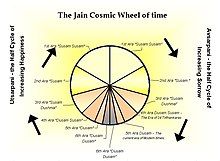This article includes a list of general references, but it lacks sufficient corresponding inline citations. Please help to improve this article by introducing more precise citations. (April 2017) (Learn how and when to remove this message)
|
Avasarpiṇī is the descending half of the cosmic time cycle in Jainism and the one in which the world is said to be at present. According to Jain texts the Avasarpiṇī is marked by a decline in goodness and religion. The ascending half of the cycle is called utsarpiṇī, which is marked by the ascent of goodness and religion.

Jaina cosmology divides the worldly cycle of time (kalpakāla) in two parts or half-cycles (kāla) – ascending (utsarpiṇī) and descending (avasarpiṇī) – each consisting of 10 x 1 crore x 1 crore addhāsāgaropama (10 kotikotī sāgaropama). Thus, one cycle of time (kalpakāla) gets over in 20 kotikotī sāgaropama.[1]
During the ascending period (utsarpiṇī) of the half-cycle (kāla), in the regions of Bharata and Airāvata, there is the all-round increase in age, strength, stature and happiness of the living beings, while during the descending period (avasarpiṇī) of the half-cycle, there is the all-round deterioration. Each half-cycle is further divided into six periods of time. The periods in the descending (avasarpiṇī) half-cycle are termed as:[2]
The fifth period (dusamā) of the avasarpiṇī is generally called Panchama Kāla.[4] According to Jain texts, we are presently living in this period of time which started after 3 years and 8+1⁄2 months of the liberation (nirvāṇa) of the 24th Tīrthankara Mahāvīra.[2] It is said that at the end of this period, humans will be no more than one cubit in height, and twenty years in age.[4] Bharata Chakravartin is said to have seen 16 dreams which were related to this period. These were explained by Tirthankara Rishabhanātha.[5]